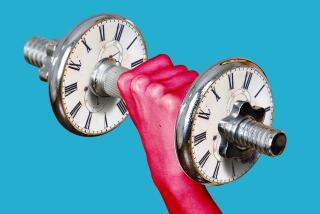Study Shows Older Exercisers’ Strong Gains
WASHINGTON — Older exercisers have youthful potential to gain strength if they work hard at it, researchers find.
Leg muscle strength increased up to 84% over 16 weeks among men ages 60 to 75 who did weight-training-type exercises at an intensity that matches gym rats in their 20s, the researchers found. And the older exercisers’ increases in muscle fiber size were proportionate to the gains showed by younger exercisers.
“Elderly men cannot only tolerate these very high workloads but will exhibit muscular changes similar to their younger counterparts,” said one of two studies on the men, both published in the Journal of Gerontology.
Ohio University scientists looked at healthy men who kept active but did no regular weight training. Nine were put on a training program that had them doing leg extensions. The men first did 10 repetitions at 50% of the maximum they could lift at one time. They then did three sets of 6 to 8 repetitions at 80% to 85% of their one-time maximums. The men did this twice a week. The other nine did no weight training and served as a comparison group.
Although both groups were similar at the start, the exercisers had pulled well ahead at the end of the 16 weeks. They averaged 50% better on the extension, 72% better on the press and 84% better on the half squat, the study said.
The scientists also found the exercisers gained endurance--the men’s hearts had to work less hard at a given intensity in a treadmill test. There was no such improvement in the nonexercising comparison group.
The researchers took raisin-sized samples of muscle tissue by biopsy. They found the exercisers had fewer Type IIB muscle fibers, a type associated with inactivity, and more Type IIA, a trained-muscle form that increases with exercise, said researcher Robert S. Staron. The workout regimen apparently triggered a transformation in fiber type similar to that seen in athletes, he said.
The exercise paid off in lifestyle improvements, Staron said. “All of them indicated they felt better,” he said. “They were doing more things. They felt much more comfortable and much more strong in their daily activities.”
The companion report in the journal took a closer look at changes in the size of the cells. The cells in the exercisers grew by 30%, the study said. That’s similar to what’s found in men in their 20s who weight train, said researcher Robert S. Hikida.
The research is in line with other studies on resistance exercise, even at high intensities, said researcher William J. Evans of the University of Arkansas for Medical Sciences, who was not part of the studies. And the gains can be dramatic among people who have done no previous exercise, he said.
The idea that older people must resign themselves to inactivity and frailty is old-fashioned, said Dr. Walter R. Frontera, a researcher at Harvard-affiliated Spaulding Rehabilitation Hospital, Boston.
Although age does mandate limits on how much strength an exerciser can gain, researchers increasingly are unsure what the limit might be, Frontera said. “It is not easy to identify a plateau in their strength gains,” he said.
For sedentary older folks the gains can be dramatic, and even in veteran masters athletes, some gains may be possible, Frontera said. “They will reach a limit,” he said. “I don’t think we know what the limit is, which is the interesting question.”
*
National Institute on Aging exercise site: https://www.aoa.dhhs.gov/aoa/pages/agepages/exercise.html
Encyclopedia of Sports Medicine and Science exercise and aging site:
https://www.sportsci.org/encyc/agingex/agingex.html






